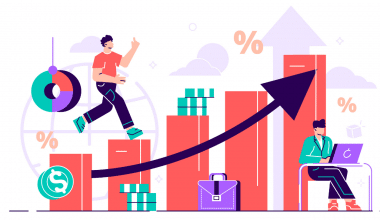Product development is a fascinating and challenging effort. No two product launches are the same, from initial concept to research and development. There is, however, a general approach that might assist you in getting started with the product development process. The product development process outlines the steps to bring a product from concept to market launch. This comprises defining a market need, studying the competitors, developing a product roadmap, and creating a minimum viable product (MVP). In this guide, we’ll cover all you need to know about the new product development process, as well as some steps and techniques to optimize the life cycle of the process to help you bring your idea to life!
What is Product Development?
Product development encompasses the entire process of bringing a product to market. It also includes the renewal of an existing product and the introduction of an old product into a new market. This process is part of identifying market needs, envisioning the product, developing the product roadmap, launching the product, and collecting feedback.
New product development (NPD) is an essential component of product design. The procedure does not conclude until the product life cycle is completed. You can keep collecting customer input and iterating on new versions by improving or adding new features.
There is no single position responsible for product development. Product development unifies every department of any organization, whether a startup or a large corporation, including design, engineering, manufacturing, product marketing, UI/UX, and others. Each group is vital to the product’s definition, design, building, testing, and delivery.
Steps in the Product Development Process
The process of bringing an original product concept to market is known as new product development (NPD). Agile software development principles can also tremendously assist NPD. Although the product development process varies by industry, it may be divided into seven stages: ideation, research, planning, prototyping, sourcing, costing, and commercialization.
Use the development architecture outlined below to bring your product idea to market.
#1. Idea generation
Many budding entrepreneurs become stuck at the first stage, which is creativity and brainstorming. This is frequently due to them hoping for a stroke of genius to reveal the right thing to market. While creating something genuinely “new” might be creatively gratifying, many of the best ideas come from iterating on an existing product.
#2. Market Research
With your product idea in mind, you may be tempted to rush into production, but this can be a mistake if you fail to validate your idea first. Product validation assures that you are developing a product that people will pay for and that you are not wasting time, money, and effort on an idea that will not sell. One effective method to validate your product idea is by conducting comprehensive market research surveys.
#3. Planning
It’s critical to plan ahead of time before beginning to build your prototype because product development can quickly become complicated. A detailed product roadmap can frequently be beneficial at this stage. When you eventually approach manufacturers or begin looking for materials, it’s easy to become confused in the succeeding steps if you don’t have a clear notion of your product’s design and how it will perform.
#4. Prototyping
The prototyping phase of product development aims to create a finalized product that can be used as a sample for mass manufacturing. It’s doubtful that you’ll get to your completed product in a single attempt—typically, prototyping entails testing with numerous versions of your product, gradually removing alternatives, and making adjustments until you’re satisfied with a final example. A minimal viable product is a beautiful benchmark to aim for.
#5. Sourcing
When you have a product prototype that you are happy with, it is time to start gathering resources and securing production partners. This is also known as creating your supply chain: the vendors, activities, and resources required to generate a product and get it into the hands of a client. Project management is critical at this stage of product development.
#6. Costing
After you’ve completed your research, planning, prototyping, and sourcing, you should have a better idea of how much it will cost to manufacture your product. Costing is a business analysis procedure in which you total up all of the information obtained thus far to establish your cost of goods sold (COGS) to determine a retail price and gross margin.
#7. Commercialization
You now have a profitable and successful product ready for the world. The final stage in this process is to take your product to market! A product development team will now hand over the reins to marketing for a product launch. Don’t worry if you don’t have the budget for expensive advertisements.
Product Development Life Cycle
The Product Development Life Cycle (PDLC) describes a product’s stages from conception through retirement. The PDLC is a framework that assists firms in planning, designing, developing, testing, and launching profitable products that match customer needs. The common stages of the PDLC are as follows:
#1. Idea Generation
This is the stage at which new product ideas or upgrades are generated. Brainstorming, market research, consumer feedback, and internal ideation sessions can help.
#2. Concept development
The ideas are analyzed and filtered at this step to identify the most promising ones. The chosen ideas are subsequently developed into concepts that outline the product’s characteristics, benefits, and target market.
#3. Design and planning
The product’s design and specs are developed at this stage. This comprises developing product prototypes, testing them, and improving the design until it fits the needs of the product.
#4. Development
This is the stage at which the product is created. This comprises coding, designing, and building the product. Documentation, manuals, and other materials required for marketing and support are also created during the development stage.
#5. Testing
The product is tested at this step to confirm that it meets the product’s specifications and performs as intended. Functional testing, performance testing, and usability testing are all types of testing.
#6. Launch
The product is released to the public. Marketing materials, advertising, and sales promotions are all part of this. The launch stage also entails training sales and support personnel and making the product accessible for purchase.
#7. Maintenance
The product is maintained and supported at this point. Bug fixes, upgrades, and customer support are all part of this. The maintenance stage can span several years before the product is discarded.
#8. Retirement
The product is removed from the market at this point. When a product is no longer profitable, or when it is replaced by a newer version or a different product, this can occur. During the retirement stage, any remaining inventory and assets must be disposed of.
Product Development Techniques
Product development process techniques are tools and procedures for creating new products or improving existing ones. Here are some examples of common product development techniques:
#1. Design thinking
This is a problem-solving strategy that promotes empathy, creativity, and experimentation. It entails understanding the requirements and desires of clients and applying that knowledge to generate new solutions.
#2. Agile development
This method promotes adaptability, teamwork, and iterative development. It entails breaking the product development process down into little, manageable portions and testing and refining each one before going on to the next.
#3. Lean development
This is a methodology that stresses reducing waste while increasing value. It entails concentrating on a product’s most crucial features and functionalities while eliminating anything that does not offer value.
#4. Rapid prototyping
A rapid and rough prototype of a product is created to test its feasibility and functionality. Rapid prototyping enables rapid iteration and testing, which can aid in identifying potential concerns early on.
#5. Concurrent engineering
This entails bringing together many teams and departments involved in the product development process to collaborate simultaneously. This can cut development time while also improving communication and teamwork.
#6. Voice of the Customer (VOC)
This is a technique for getting client feedback via surveys, interviews, or other methods. The input is utilized to determine client wants and preferences and to create goods that satisfy those needs.
#7. Quality Function Deployment (QFD)
This is a strategy for turning consumer requests into particular engineering requirements. QFD ensures that the product development process is centered on addressing the demands and preferences of the consumer.
#8. Six Sigma
This is a methodology that stresses defect reduction and quality improvement. It entails identifying and eliminating sources of variance in the product development process using statistical analysis and other methods.
What are Real-World Examples of Product Development Processes?
Airbnb’s founders had no business or finance, but they intuitively recognized one of the most critical aspects of successful product development: confirming your product concept before beginning production.
#1. Airbnb
They put their peer-to-peer rental housing concept to the test online, posting information about their flat and offering it as a short-term rental. They believed they had a feasible product idea when numerous users joined to stay at the founders’ house.
#2. Crystal Pepsi
PepsiCo made a significant error when it debuted Crystal Peps, a new soda touted as healthier than the company’s existing soft drinks. The company failed to validate its concept before going to market. Pepsi’s management was caught off guard when its full-scale rollout of Crystal Pepsi failed due to a lack of early input from its target customers and the use of a soft launch to validate the product with early adopters.
What is Product Development Strategy?
A product development strategy is a plan or approach that a company uses to create and bring new products to market. It involves identifying customer needs and preferences, analyzing market trends and competition, and developing a product that meets them.
What Is Phase 4 of the New Product Development Process?
Phase 4 of the new product development process is the commercialization phase, also known as the launch phase. It is the final stage of the product development process and involves bringing the product to market. During this phase, the product is introduced to the target market and made available for sale.
The commercialization phase includes the following key activities:
- Finalizing product design
- Manufacturing and production
- Developing marketing and sales strategies
- Establishing distribution channels
- Launching the product
- Monitoring and evaluating
What Are the Phases of Product Production?
The phases of product production, also known as the manufacturing process, typically include the following steps:
- Product Design
- Prototype Development
- Material Procurement
- Production Planning
- Manufacturing
- Quality Control
- Packaging and Shipping
- After-sales Support
What Is Product Development Process in Operations Management?
The product development process in Operations Management is a set of activities that involve designing, developing, and launching new products or services. It is a critical function in operations management as it helps organizations introduce new products that meet customer needs, capture market share, and generate revenue.
What Is the First Step in the New Product Development Process?
The first step in the new product development process is idea generation. This is the stage where new product ideas or product improvements are generated and evaluated. Idea generation can come from various sources, including customer feedback, market research, or internal brainstorming sessions.
Conclusion
In summary, the product development process is a critical function of any organization involved in the creation and launch of new products or product improvements. The process typically involves several stages, including idea generation, concept development, product design and development, testing, launch, and post-launch evaluation.
A well-executed product development process can help organizations identify and capitalize on new market opportunities, differentiate from competitors, and increase revenue and profitability. Organizations can use various product development techniques and methodologies, such as design thinking, agile development, and lean development, to optimize the process and increase the chances of success. Ultimately, a successful product development process requires a deep understanding of customer needs and preferences, a willingness to take risks and innovate, and a commitment to continuous improvement and customer satisfaction.
- PRODUCT DEVELOPMENT LIFECYCLE: Definition, Process & Stages
- WHAT IS CUSTOMER SUPPORT: Definition, Types, and Benefits
- WHAT IS PRODUCT MARKETING: What It Is, Examples & Guide
- STAGES OF THE EMPLOYEE LIFE CYCLE EXPLAINED!
- How Customer Support Can Increase Customer Satisfaction
- TRADITIONAL MARKETING: Definition, Types & Differences






